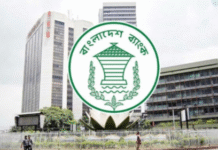BB officials speak on external trade openness

Bangladesh has made significant improvements in trade liberalisation in recent times due to numerous policy reforms.
In terms of total trade as percentage of gross domestic product, the country is now the second most open economy, after Sri Lanka, among the four major economies of South Asia.
The country’s trade-GDP ratio reached 47.1 percent in fiscal 2012-13, up from 30 percent in fiscal 1999-2000, data from Bangladesh Bank shows.
“As reform and liberalisation measures were being pursued, the degree of integration of Bangladesh economy with world economy has increased gradually,” said a paper jointly written by Abdul Wahab and Mazbah Uddin, joint directors of BB.
They made a presentation at a seminar of Saarc Finance, a grouping of governors and finance secretaries in South Asia, at Ruposhi Bangla Hotel in Dhaka yesterday.
Absence in the limits of foreign equity participation in Bangladesh has made it more liberal compared to other countries in terms of provisions on inflows, it said.
Provisions on outflows of resident-owned capital, issuance of securities abroad and operations on money market by non-residents have been restricted in contrast to the provisions prevailing in the other three countries.
The overall growth scenario has improved, financial sectors have deepened, capital inflows are increasing and government efforts are continued.
However, to achieve the goal of becoming an upper middle-income group country, Bangladesh needs more foreign direct investment.
In line with a number of developing economies, Bangladesh has undertaken measures and reforms in external sector to attract higher level of FDI and to obtain positive benefits from external sector.
These policy reforms and greater capital flows into the economy are expected to bring significant improvement in the external financial integration status and growth prospectus of the country.
So far, these reforms are not sufficient to attract foreign investors. Full capital mobility is one of the important concerns to authority, thus a roadmap for such activities has been designed.
The success of such roadmap will depend on overall macroeconomic conditions as well effectiveness of the coordinated efforts of BB and other related organisations.
Meanwhile, the volume and size of exports increased gradually over the last two decades. During the 1980s, Bangladesh earned $435.6 million from exports of goods and services on average, which was 4.0 per cent of GDP. It increased almost twenty times over the next three decades, the paper said.
In today’s globalised world, external trade openness is crucially important for growth as it frees up efficient domestic producers from demand limitations of the local markets, said Atiur Rahman, governor of Bangladesh Bank.
Openness to global capital flows likewise spurs growth by attracting investment inflows. But, at the same time, heightens instability risks from volatile trends of global capital flows, arising both from speculative position-taking and from spill-overs of persistent imbalances in major economies, he said.
External opening up also poses new demands on approaches in safeguarding of monetary and financial stability.
AB Mirza Azizul Islam, a former finance adviser to caretaker government, also presented a keynote paper on external sector management in South Asia.
Source: The Daily Star









